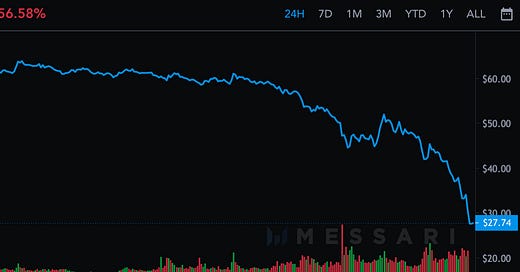UST has lost its peg for hours, unheard of for an $18 billion stablecoin. Even concerted efforts by trading firms with billions of dollars in backing have failed to keep it up. How did this happen?
Let’s take a little tour into memory lane with a billionaire sports team owner and an yield farming team trying to reimburse their tokenholders for a previous project failure.
Stablecoins
Stablecoins are a critical piece of onchain finance, letting people enjoy all the benefits of superior crypto infrastructure without the painful volatility of token speculation.
Consider a world without them. A big part of the 2017 ETH boom was people desperate to get their hands on ETH so they could participate in ETH-denominated ICOs. And the following 2018 ETH bust was team members offloading their ETH treasuries. Contrast this with the 2021 cycle where many projects held stablecoin-denominated sales, reducing volatility at both ends.
And a final disclaimer: algostables do not represent stablecoins. Fully-collateralized stables with a regulated centralized issuer such as USDC have functioned flawlessly for years. Over-collateralized stablecoins with decentralized smart contract issuers such as Dai have done the same. There are plenty of safe, reliable stablecoins out there for users who don’t cut corners.
Iron Finance and the fall of Mark Cuban
It’s summer 2021. We have ample evidence that a stablecoin backed by 100% dollars can hold its peg. A DeFi team named Iron Finance decided to push the limits - what if we backed with 75% dollars and 25% governance token? Users would have assurance it was impossible for their investment to death spiral to zero, and the protocol would benefit from issuance flexibility and native demand.
The stablecoin was called $IRON, backed by 75% USDC and 25% native token named $TITAN. Users could only mint new stablecoins by depositing the proper mix of USDC and TITAN, so to participate in initial liquidity mining they had to purchase TITAN off the market. Since rewards for liquidity provision were denominated in TITAN, a rising TITAN price meant rising demand for the stablecoin. The virtuous cycle follows:
1) Attractive farming rewards in the IRON/USDC pool
2) User purchases TITAN
3) User deposits USDC and burns TITAN to mint IRON
4) User deposits IRON into pool
5) TITAN price increases, farming rewards become even more attractive
6) Repeat
An infinite money machine! Or so many thought, as the protocol reached almost a billion dollars of TVL (total value locked) at its apex. IRON held its peg nicely, TITAN ran all the way from under a dollar to $65, and everyone was in profit. Even Mark Cuban got in on the fun!
Then came the redemption demands. That virtuous cycle looks pretty ugly when you run it in reverse.
1) User withdraws IRON from pool
2) User burns IRON and receives USDC deposits plus freshly minted TITAN
3) User sells TITAN
4) TITAN price decreases, farming rewards become less attractive
5) Repeat
Worst of all, the liquidity in the TITAN-MATIC liquidity pool quickly dried up as people realized the farming rewards didn’t compensate for the price risk they were taking on. Dumping tokens into an illiquid pool is a recipe for massive red candles, and LPs fled. The protocol had to mint increasing amounts of TITAN to compensate stablecoin redeemers, and the supply of this governance token went from the millions into the quadrillions, and then into numbers with too many zeros to mention.
In a matter of days, TITAN crashed from $65 to $0.000000035. Not a typo. The IRON peg held strong at $0.75, not at $1.00. The USDC was still there, but any trace of demand for the governance token had vanished. And so this algostable reduced to the value of its partial collateral backing. Mark Cuban, sorely disappointed, took to the television circuit to advocate for DeFi regulation.
The team is still at it, and helpfully left up the docs with detailed parameters for the failed project. Check them out if you’re curious!
Luna, Terra, and the Foundation Guard
While TITAN peaked at a 9-figure marketcap, there are bigger fish to fry.
$LUNA is the native token of the Terra blockchain, reaching a marketcap of $40 billion at its peak. $UST is a stablecoin backed by LUNA with an $18 billion market cap. You can always redeem LUNA for UST, and vice-versa. If LUNA is $100, you can redeem it for 100 UST. You can also redeem 100 UST for 1 LUNA. This is the stability mechanism. If UST has lost its peg and is trading at $0.95, you can still redeem 100 UST for 1 LUNA and sell the LUNA for $100, a risk-free profit of $5. Therefore arbitrageurs should keep the system in line.
The UST utility comes from the Anchor protocol, a money market which offers 20% yields on UST. Protocols such as Abracadabra’s Degenbox have spun up to capture the basis on this trade - borrow at 2%, invest at 20%, leverage up and capture the spread.
If you look closely, you’ll notice that the TITAN-IRON relationship is the same as the LUNA-UST relationship, with one glaring difference: IRON was 75% collateralized if demand for TITAN collapses, while UST is 0% collateralized if demand for LUNA collapses.
The fix was clever: raise a billion dollars in a Luna OTC deal from top institutional players such Jump, and 3 Arrows Capital. The Luna Foundation Guard (LFG) deployed these funds to purchase Bitcoin over the past couple weeks, helping BTC rally from 35k to 47k. The news also caused LUNA to run from $50 to $120, and much LUNA was burned at these high prices to mint UST.
Now the LFG holds several billion dollars of Bitcoin to support the $18 billion UST market cap. From 0% collateralized to 20% collateralized, a significant improvement! But unfortunately the mechanics are still the same.
When Arbitrageurs Quit
A token doesn’t need backing to have a nonzero market price. You cannot redeem ETH for any ecosystem reserves, yet it’s worth several thousand dollars. Market price is determined by where a willing buyer meets a willing seller, for any reason. So despite having only partial backing, UST has held its peg (with one brief exception) over the past few months. Deep liquidity in the UST-3crv Curve metapool has been key here. Buys and sells have not been enough to move the price, and arbitrageurs have been happy to keep price in place. Everything humming along as it should.
But after six straight red weeks on the crypto majors, something had to give. Accusations of foul play circle around Twitter as unknown players dump 9-figure market sells into the pool.

UST gets dumped, UST depegs, UST holders redeem for LUNA to arbitrage the token back into place, and LUNA gets dumped. Marginal sells can have outsized impact on market caps, and it wasn’t long before we saw LUNA marketcap dip below the UST marketcap. This is a critical sign of loss of confidence.
How It Ends
Nobody’s quite sure. The BTC reserves provide some UST backing, but 20% collateralization is nowhere near enough to satisfy everyone who wants to get out. Anchor reserves are dropping rapidly by the minute. LUNA faces massive liquidations as UST faces massive redemptions.
TITAN went from $65 to $0.000000035.
LUNA has dropped from $120 to $27 at time of publication, down 57% in a single day.
How low do we go? Stay tuned to find out!








So stoked to get a write up from you, that isn’t a tweet. Thanks, bigly! This post really helps me understand more.
Thank you for your hard work!